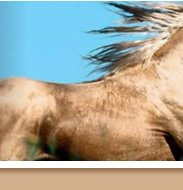Banking On The 'Money Turn'
Take control of your too-aggressive barrel racing horse and
improve his first barrel turn with this tuneup from futurity
champ Talmadge Green.
Goal: To gain control of an overly aggressive running horse by
teaching him to rate (slow) his speed in response to light rein
pressure before turning the first barrel.
Benefits: By gaining control of your horse's body, you'll be
able to position him for a precise first turn; properly align
him for the other two turns; and shave seconds off your time.
In barrel racing, the first barrel is commonly called the "money
barrel," because the outcome of this turn determines the fate of
your run. To meet this high-speed challenge, a horse must have a
measure of aggressiveness, but many barrel horses-especially
seasoned ones- begin running too aggressively to the first
barrel.
barrel racing
Talmadge Green
If your horse fits this description, he's become the driver and
you're his passenger: He no longer waits for your rate cue.
Instead, he dives into the turn, dropping his shoulder (and
usually knocking over the barrel), or he blows past it, throwing
off his straight-line approach to the next barrel.
You can regain control using the simple exercise I'll give you
here. With repetition, it'll put you back in the driver's seat,
and will help you gauge your horse's speed, so you can position
him for a clean, razor-sharp turn.
1. Take your horse to the arena location where you'd normally
ask him to initiate a barrel run. Place one hand on the saddle
horn and the other on the reins-just as you would on a run.
Maintaining light rein pressure while sitting squarely, not
forward in your saddle, ask him to lope halfway to the first
barrel. This will enable you to balance yourself, and will help
your horse set himself for the turn by tucking his hind legs
under his body. (If he becomes chargy or anxious, stop him, then
trot him to the midpoint.)
2. At the halfway point, bring your horse down to an extended
trot. Begin lifting his shoulder and positioning his front end
for the turn by sliding your hand down the inside rein and
slightly picking up on it, so your thumb is facing upward. Use
neck-rein cues to guide him to a spot 6 to 7 feet to the side of
the barrel, an area known as "the pocket."
3.
When your horse's nose is even with the barrel, ask him to stop.
Immediately back up 1 or 2 steps, then settle for about 10
seconds. You want your horse to learn to rate himself going into
the pocket, and by asking him to stop and settle there you're
telling him to do so. The stop also rocks his weight onto his
hindquarters; the back-up causes him to drive his inside hind
pivot foot under his body, properly positioning him for a strong
push off when exiting the turn; the settle will take the "rush"
out of his maneuver. If your horse won't stand completely still,
do the best you can, gradually asking him to settle longer with
each repetition.
4. Ask your horse to walk around the barrel. As you make the
turn, look at the barrel and evaluate your and your horse's
position. If your horse drops his shoulder (his front end will
become heavy and it'll feel like he's leaning against your
inside rein and leg), pick up on your inside rein to lift his
shoulder. Apply inside or outside rein pressure as needed to
adjust his position. Circle the barrel at least twice to keep
him from prematurely exiting the turn, which often leads to a
too-wide exit.
5. With practice at slower gaits, your and your horse's form
will become automatic when you increase your speed. Here's the
final result : My horse's shoulder is upright and balanced, his
front legs are reaching and pulling the ground toward him, and
his inside pivot foot is planted under his body. We can take
this turn to the bank. |
![]()
![]()
![]()
![]()
![]()
![]()

![]()
![]()
![]()
![]()
![]()
![]()
![]()
![]()



